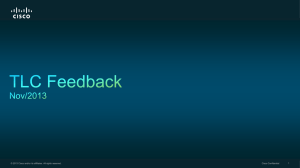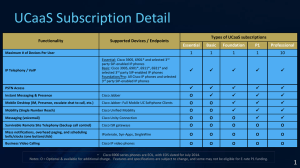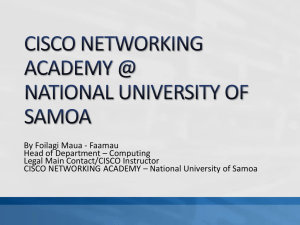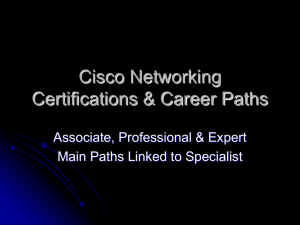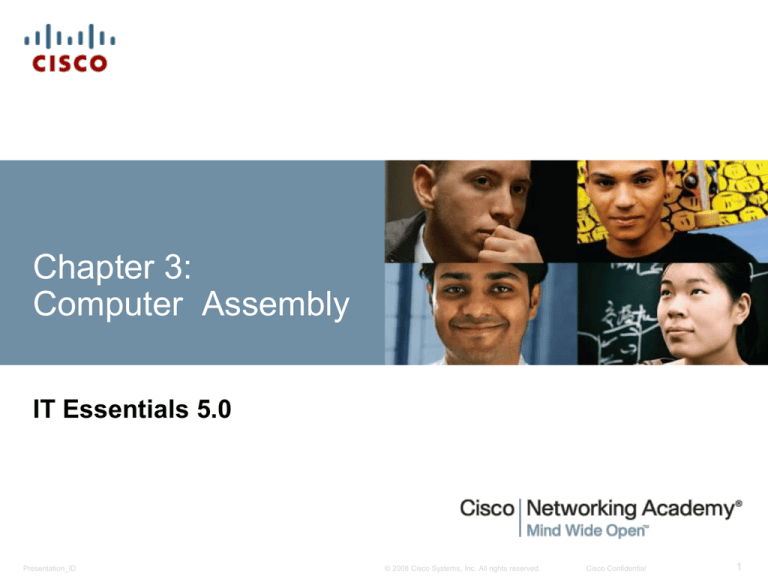
Chapter 3:
Computer Assembly
IT Essentials 5.0
Presentation_ID
© 2008 Cisco Systems, Inc. All rights reserved.
Cisco Confidential
1
Chapter 3 Objectives
3.1.1 Open the case
3.1.1 Install the power supply
3.1.2 Attach the components to the motherboard and
install the motherboard
3.1.3 Install internal drives and drives in external bays
3.1.4 Install adapter cards
3.1.5 Install and connect all internal cables
3.1.5 Re-attach the side panels and connect external
cables to the computer
3.2.1 Boot the computer for the first time
3.2.2 Configure BIOS
Presentation_ID
© 2008 Cisco Systems, Inc. All rights reserved.
Cisco Confidential
2
Chapter 3 Objectives
3.3 Describe reasons for upgrading computer
components
3.3.1 Select and install replacement or upgraded
motherboard, CPU, heat sink and fan, and RAM
3.3.1 Upgrade and configure BIOS
3.3.2 Select and install replacement or upgraded hard
drives
3.3.3 Select and install replacement or upgraded input
and output devices
Presentation_ID
© 2008 Cisco Systems, Inc. All rights reserved.
Cisco Confidential
3
Open the Case
Computer assembly is a large part
of a technician's job.
Prepare the workspace before
opening the computer case.
There are different methods for
opening cases. Consult the user
manual or manufacturer's website.
Presentation_ID
© 2008 Cisco Systems, Inc. All rights reserved.
Cisco Confidential
4
Install the Power Supply
Power supply installation steps include the following:
1. Insert the power supply into the case.
2. Align the holes in the power supply with the holes in
the case.
3. Secure the power
supply to the case
using the proper
screws.
Presentation_ID
© 2008 Cisco Systems, Inc. All rights reserved.
Cisco Confidential
5
Attach Components to the Motherboard
CPU on Motherboard
• The CPU and motherboard are sensitive to electrostatic
discharge.
• The CPU is secured to the socket on the motherboard with a
locking assembly.
• CAUTION: When handling a CPU, do not touch the CPU
contacts.
Thermal compound
• Helps keep the CPU cool.
• To install a used CPU, clean it and the base of the heat sink
with isopropyl alcohol to remove the old thermal compound.
Heat Sink/Fan Assembly
• The Heat Sink/Fan Assembly is a two-part cooling device.
• The heat sink draws heat away from the CPU.
Install RAM
• RAM provides temporary data storage for the CPU and
should be installed in the motherboard before the
motherboard is placed in the computer case.
Presentation_ID
© 2008 Cisco Systems, Inc. All rights reserved.
Cisco Confidential
6
The Motherboard
After installing the previous components, the
motherboard is now ready to install in the computer
case.
Plastic and metal standoffs are used to mount the
motherboard and to prevent it from touching the metal
portions of the case.
Presentation_ID
© 2008 Cisco Systems, Inc. All rights reserved.
Cisco Confidential
7
Install Internal Drives
Drives that are installed in internal bays are called
internal drives.
A hard disk drive (HDD) is an example of an internal
drive.
HDD installation steps:
1. Position the HDD so that it aligns
with the 3.5-inch drive bay.
2. Insert the HDD into the drive bay so
that the screw holes in the drive line
up with the screw holes in the case.
3. Secure the HDD to the case using
the proper screws.
Presentation_ID
© 2008 Cisco Systems, Inc. All rights reserved.
Cisco Confidential
8
Install Drives in External Bays
Drives in external bays allow access to the
media without opening the case.
Some devices that are installed in this type
of drive are:
Presentation_ID
•
An optical drive is a storage device
that reads and writes information to
CDs, DVDs, or BDs.
•
A floppy disk drive (FDD) is a storage
device that reads and writes
information to a floppy disk.
© 2008 Cisco Systems, Inc. All rights reserved.
Cisco Confidential
9
Install Adapter Cards
Adapter cards are installed to add functionality to a computer.
Some examples of these adapters are:
• A Network Interface Card (NIC) which enables a computer to
connect to a network. It uses PCI and PCIe expansion slots on
the motherboard.
Presentation_ID
•
A wireless NIC enables a computer to connect to a wireless
network. Wireless NICs use PCI and PCIe expansion slots on the
motherboard. Some wireless NICs are installed externally with a
USB connector.
•
A video adapter card is the interface between a computer and a
display monitor. An upgraded video adapter card can provide
better graphic capabilities for games and graphic programs.
Video adapter cards use PCI, AGP, and PCIe expansion slots on
the motherboard.
© 2008 Cisco Systems, Inc. All rights reserved.
Cisco Confidential
10
Connect Internal Cables
Power cables are used to distribute electricity from the
power supply to the motherboard and other components.
ATX
Presentation_ID
AUX
SATA
Molex
© 2008 Cisco Systems, Inc. All rights reserved.
Berg
Cisco Confidential
11
Connect Internal Cables
Data cables transmit data between the motherboard and
storage devices, such as hard drives. Some of examples of
this type of cables are:
• PATA cable
• SATA cable
• Floppy drive data cable
Additional cables connect the buttons and link lights on the
front of the computer case to the motherboard.
Presentation_ID
© 2008 Cisco Systems, Inc. All rights reserved.
Cisco Confidential
12
Complete Physical Installation
Now that all the internal components and the
power supply have been installed and connected to
the motherboard, the following tasks should be
completed:
•Re-Attach the side panels: Most computer cases have
two panels, one on each side. Some computer cases
have one three-sided cover that slides down over the
case frame.
•Connect the External Cables: These cables are
normally connected to the back of the computer. Here are
some common external cable connections: Monitor,
Keyboard, Mouse, USB, Ethernet, Power.
Presentation_ID
© 2008 Cisco Systems, Inc. All rights reserved.
Cisco Confidential
13
Boot Computer for the First Time
When the computer is booted, the basic input/output
system (BIOS) will perform a power-on self test (POST)
to check on all of the internal components.
The BIOS contains a setup program used to configure
settings for hardware devices. The configuration data is
saved to a special memory chip called a
complementary metal-oxide semiconductor (CMOS)
or can be saved in nonvolatile memory which does
not need power to retain settings.
POST checks to see that all of the hardware in the
computer is operating correctly. If a device is
malfunctioning, an error or a beep code alerts the
technician that there is a problem.
Presentation_ID
© 2008 Cisco Systems, Inc. All rights reserved.
Cisco Confidential
14
BIOS Configuration
Technicians use the BIOS information to learn
about installed components:
• CPU – Manufacturer and speed
• RAM - Manufacturer and speed
• Hard Drive - Manufacturer, size, and type
• Optical Drive - manufacturer and type
Technicians use BIOS to:
• Set Time and Date
• Disable Devices
• Set Boot Order
• Adjust Clock Speed
• Enable Virtualization
Presentation_ID
© 2008 Cisco Systems, Inc. All rights reserved.
Cisco Confidential
15
BIOS Configuration
Technicians can set the following BIOS security
features
BIOS passwords
Drive encryption
Trusted Platform Module (TPM)
Lojack
• Lock the computer remotely.
• Display a message so that a lost computer can be returned to
the owner.
• Delete sensitive data on the computer if stolen.
• Locate the computer using geotechnology.
Presentation_ID
© 2008 Cisco Systems, Inc. All rights reserved.
Cisco Confidential
16
BIOS Configuration
Bios Built-in Hardware Monitoring
Temperatures
Fan Speeds
Voltages
Clock and Bus Speeds
Intrusion Detection
Built-in Diagnostics
Start test, Hard drive test, Memory test
Presentation_ID
© 2008 Cisco Systems, Inc. All rights reserved.
Cisco Confidential
17
Motherboard Component Upgrades
If the motherboard is upgraded or replaced, the
CPU may need to be replaced
CPU architectures are installed in these common
socket connection designs:
• Zero-Insertion Force (ZIF)
• Land Grid Array (LGA)
• Pin Grid Array (PGA)
• Single-Edge Connector (SEC) – no longer commonly used
• Low-Insertion Force (LIF) - no longer commonly used
Presentation_ID
© 2008 Cisco Systems, Inc. All rights reserved.
Cisco Confidential
18
Upgrading the CPU
The new CPU must:
fit into the existing CPU socket.
be compatible with the motherboard chipset.
operate with the existing motherboard and power
supply.
must operate with the existing RAM. The RAM may
need to be upgraded or expanded to take advantage of
the faster CPU.
might require a different heat sink and fan assembly.
Presentation_ID
© 2008 Cisco Systems, Inc. All rights reserved.
Cisco Confidential
19
Upgrading RAM
Prior to upgrading or replacing the RAM, answer the
following questions.
What type of RAM does the motherboard currently
use?
Can the RAM be installed one module at a time or must
it be grouped into matching banks?
Are there available RAM slots?
Does the new RAM chip match the speed, latency,
type, and voltage of the existing RAM?
Presentation_ID
© 2008 Cisco Systems, Inc. All rights reserved.
Cisco Confidential
20
BIOS
Motherboard manufacturers periodically release
updates for their BIOS.
Modern BIOS chips are EEPROM, or flash memory,
which can be upgraded by the user without opening the
computer case. This process is called flashing the
BIOS.
Flash the BIOS through a command prompt.
Several motherboard manufacturers provide software
that allow a user to flash the BIOS from within
Windows.
Presentation_ID
© 2008 Cisco Systems, Inc. All rights reserved.
Cisco Confidential
21
Storage Devices
Reasons for installing an additional drive:
• Install a second operating system
• Provide additional storage space
• Provide a faster hard drive
• Hold the system swap file
• Back up the original hard drive
• Increase fault tolerance
When two PATA hard drives are connected to same
data cable, one drive must be jumpered as the master,
other drive must be jumpered as the slave drive.
Each SATA hard drive has its own data cable,
therefore, there is no master-slave relationship between
drives
Presentation_ID
© 2008 Cisco Systems, Inc. All rights reserved.
Cisco Confidential
22
RAID
A Redundant Array of Independent Disks (RAID)
installation can provide data protection or increased
performance when connecting multiple hard drive.
Presentation_ID
© 2008 Cisco Systems, Inc. All rights reserved.
Cisco Confidential
23
Input and Output Devices
Replacement and/ or upgrade examples:
• Change to an Ergonomic keyboard or mouse
• Add privacy and antiglare filters to a monitor
• Add additional monitors
Use the existing expansion slots or sockets.
May use a USB connection.
Add USB connections by installing a USB adapter card
or add a USB hub.
Install drivers if necessary.
Presentation_ID
© 2008 Cisco Systems, Inc. All rights reserved.
Cisco Confidential
24
Chapter 3 Summary
Computer Assembly
Installation of all computer components
Connection of all cables
Description and configuration of BIOS
Description of POST
Upgrading and Configuring a PC
Motherboard and Related Components
Storage Devices
Input and Output devices
Presentation_ID
© 2008 Cisco Systems, Inc. All rights reserved.
Cisco Confidential
25
Presentation_ID
© 2008 Cisco Systems, Inc. All rights reserved.
Cisco Confidential
26


